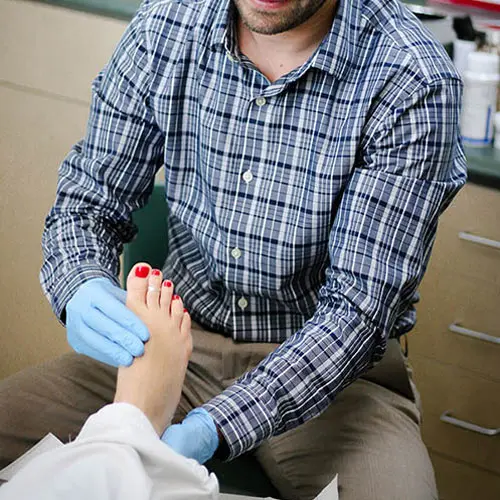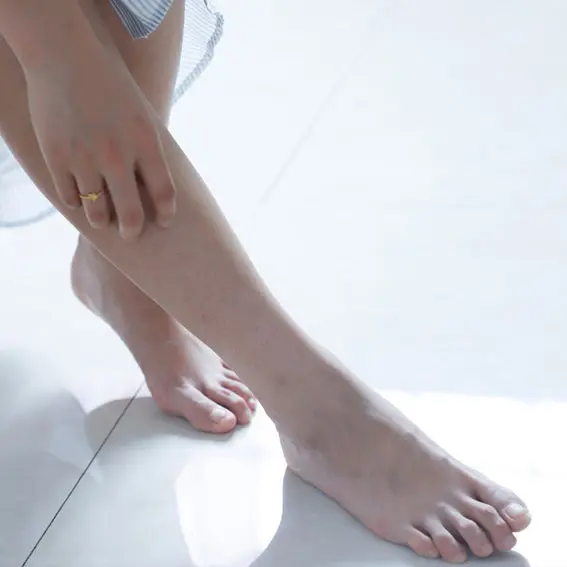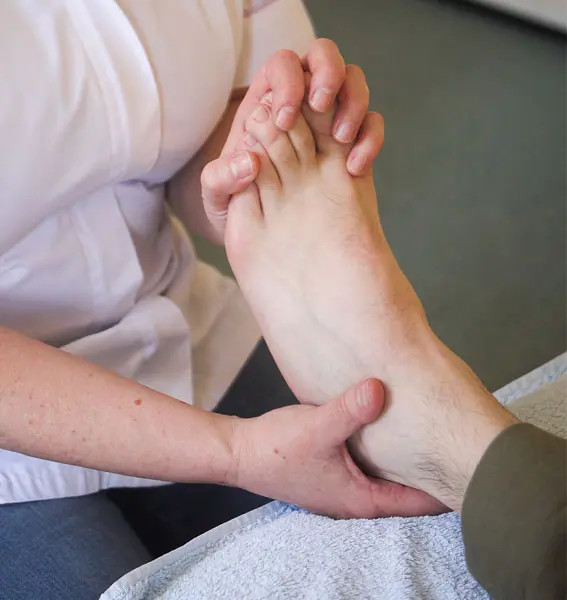Podiatrist for Heel Pain
Heel pain is one of the trickier foot problems to treat because several factors can cause it. You can take specific measures to prevent heel pain at home: wearing appropriate footwear, resting, and incorporating strength and range of motion exercises.
To reduce it, you can use massage, foot baths, and over-the-counter non-steroidal anti-inflammatory (NSAID) pain medication when feeling discomfort. However, foot pain is unlikely to resolve on its own. If you’re experiencing heel pain, have a doctor examine you for an accurate diagnosis and treatment.
Why Choose Foot & Ankle Center
When you take your car to the dealership for a problem, you will likely encounter a car salesperson who tries to convince you that a new car is better than fixing your old car, even if that’s not the case. When you find a car salesperson that says you can make your old car last a bit longer, you want to stick with them. They’ll fix your vehicle and get you back on the road. You’ll return to get a new car from them when the time comes.
In the same way, you want a heel pain doctor that recommends a course of action that keeps you on the road for as long as possible without needing new parts. At Foot & Ankle Center, Dr. Cameron is that car specialist helping you maximize the lifespan of your current car. He’s a highly skilled foot and ankle reconstruction surgeon who only recommends surgery in extreme cases. He wants treatments that provide recovery and healing for your feet. But if you need to upgrade, he’s the capable and experienced doctor you want in your operating room.

Potential Heel Pain Causes
Without an underlying condition, the top cause of heel pain is poorly fitting shoes. You can feel heel discomfort or pain if they don’t fit well or have adequate support. If you continue wearing those shoes, your heel pain can become more significant–even chronic.
Here are some other likely causes of heel pain:
- Nerve Compression
When you entrap your nerves in your lower leg or feet, it can cause shooting pains across your whole foot or have a focal point of pain in the heel or other parts of the foot. Nerve compression can come from something as simple as wearing high heels for a night. A common type of nerve compression is tarsal tunnel syndrome (TTS), which is likely to cause heel pain. TTS occurs when the posterior tibial nerve is compressed as it travels through the tarsal tunnel (on the inside of the ankle). This can result from a swollen ankle, flat feet, arthritis, diabetes, a varicose vein, or bone spur. - Arthritis or Bursitis
These conditions involve inflammation of your joints or bursae, the fluid-filled sacs around them. They can lead to pain and stiffness in the affected joints like your heels, feet, and ankles. - Plantar Fasciitis
You have a thick band of connective tissue that runs from your heel to your toes. You can irritate the plantar fascia on the bottom of your feet, leading to inflammation and excruciating heel pain. Plantar fasciitis can result from poorly fitting shoes, overuse, or obesity. If plantar fasciitis and the underlying cause are left untreated, it can cause heel spurs. These bony growths sprout on your heel bone. If they get large enough to press on the surrounding nerves or tendons, they compound your pain and often need surgery. - Achilles Tendinitis
Your Achilles tendon connects your calf muscle to your heel bone. Due to injuries, overuse, or overly tight muscles, the tendon can get irritated or inflamed, radiating pain in your heel bones. - Stress Fractures
These are small breaks in your foot bones. These can be triggered by repetitive activities, such as running, that put added pressure on your feet. However, underlying osteoporosis, a dietary deficiency, carrying too much weight around (either temporarily or permanently) can also lead to stress fractures.

Heel Pain Prevention Tips
Before you even get to the point of feeling discomfort in your heels, review these tips to see if you need to adjust your lifestyle. It can help prevent heel pain and various other foot and ankle ailments:
- Maintain a Healthy Lifestyle
By eating well, getting enough sleep, and exercising, you will be getting the proper nutrition and rest to rebuild any potential strain while strengthening your muscles to avoid injuries in the first place. If you aren’t active or overindulge, you can strain your feet excessively, increasing your risk of heel pain. - Take Care of Your Feet
Ensure you take breaks from your activities, giving adequate rest to your feet throughout the day. If you work on your feet all day, elevate your feet on your lunch break to prevent strain and inflammation. Invest in proper footwear that will give you the support and cushioning you need throughout your day. Compression stockings can also help prevent fatigue and overworked muscles. - Stretch and Strengthen
You should be stretching as part of your warm-up and cool-down exercise routine. But did you know you should also be stretching throughout the day? It helps keep your muscles limber and prevent injuries. There’s even foot yoga to strengthen your muscles and help relieve and prevent foot pain. The more robust and flexible your feet and leg muscles are, the better they can support your joints and keep you doing the activities you love.
Home Heel Pain Treatments
If you have encountered heel pain, follow the above tips while incorporating this care. If you have identified specific activities triggering your heel pain, take a break from them. Reducing inflammation is your priority, so you can allow the irritated tissues to heal.
An Epsom salt soak is an excellent home remedy to reduce inflammation. Warm water will also help with pain relief. If you can tolerate a massage, the kneading will reduce muscle tension and promote blood flow, increasing healing. You can use a tennis ball or foam roller on your feet and calves for an effective solo massage.
Over-the-counter NSAIDs like ibuprofen and icing the area will also help with your pain and swelling. For additional pain relief, you can alternate between acetaminophen and an NSAID. If these steps are not working, or you suspect that your heel pain is caused by more than wearing some tight shoes, you should consult a heel pain specialist.

Heel Pain Cures
When you see a doctor for your heel pain, they should consider your situation, underlying conditions, and current pain level to create a customized treatment plan. However, they should always start with the least invasive viable option for you. Here are some of the treatments you can expect:
- Physical Therapy
Like the prevention strategy to stretch and strengthen, physical therapy can help improve your range of motion and strength, especially if you have a previous injury. Therapists can assess your weak points and show you how you may be compensating for them. They can give you exercises to strengthen accessory muscles in your legs to prevent future injuries. - Custom Orthotics or Shoe Inserts
Shoe inserts or orthotics can redistribute pressure, provide appropriate support, and realign your feet and legs. A heel pain specialist will mold them to fit you. - Prescription Shoes
You may need prescription shoes depending on the underlying cause of your pain. In painful plantar fasciitis cases, prescription shoes will relieve the pain enough to get you moving again. After some time, you can typically wear your standard shoes with an insert. - Corticosteroid Injections
You may be familiar with cortisone shots. This anti-inflammatory medication is injected into the affected area to help treat the underlying heel pain cause such as arthritis, plantar fasciitis, and bursitis. The shot provides quick relief. However, they can weaken tissues over time, so you cannot use them excessively. - Medications
Doctors can prescribe stronger NSAIDs such as naproxen. If warranted, they may prescribe pain medication to get you through your initial injury recovery. - Shockwave Therapy
More formally known as extracorporeal shockwave therapy (ESWT), a medical professional uses high-energy sound waves to stimulate healing. ESWT works well for any soft tissue pain in your muscle, tendons, and ligaments, so doctors use it to treat the primary cause of your heel pain.
The Last Resort For Heel Pain Treatments
If nothing else has worked, your heel pain specialist will recommend surgery to help correct your foot issues. They will thoroughly discuss all surgical options and explain them in greater detail. You need an accurate assessment and diagnosis to determine the most beneficial surgery.
For example, if you have ruptured or torn your Achilles tendon, you may need a surgical repair to regain function and alleviate heel pain. Surgeons perform nerve decompressions if that’s the root cause of your pain. For plantar fasciitis, you may have a plantar fasciotomy or calcaneal osteotomy to relieve the pressure on the fascia. If you have extremely high or fallen arches, the calcaneal osteotomy can help reduce your heel pain by repositioning your heel bone. If you have heel spurs, you can have a procedure to remove them.
Ultimately, surgeries fix structural issues, relieve tissue or nerve pressure, and cure heel pain. However, they are not without risks and aren’t the easy cure-all you may have thought you were getting. After surgery, you will likely need more rest, ice, medication, and physical therapy.

Educated at Temple University School of Medicine with a podiatric surgical residency, Dr. Cameron is well-equipped to handle heel pain treatment and any other podiatry needs. A local from Utah with his own history as a podiatry patient, he established his practice in 2016 to help others dealing with foot and ankle problems. He understands how difficult it can be to know who to trust with your foot care. He has dedicated his career to being that trustworthy physician to deliver the best heel pain treatment for your unique needs.
